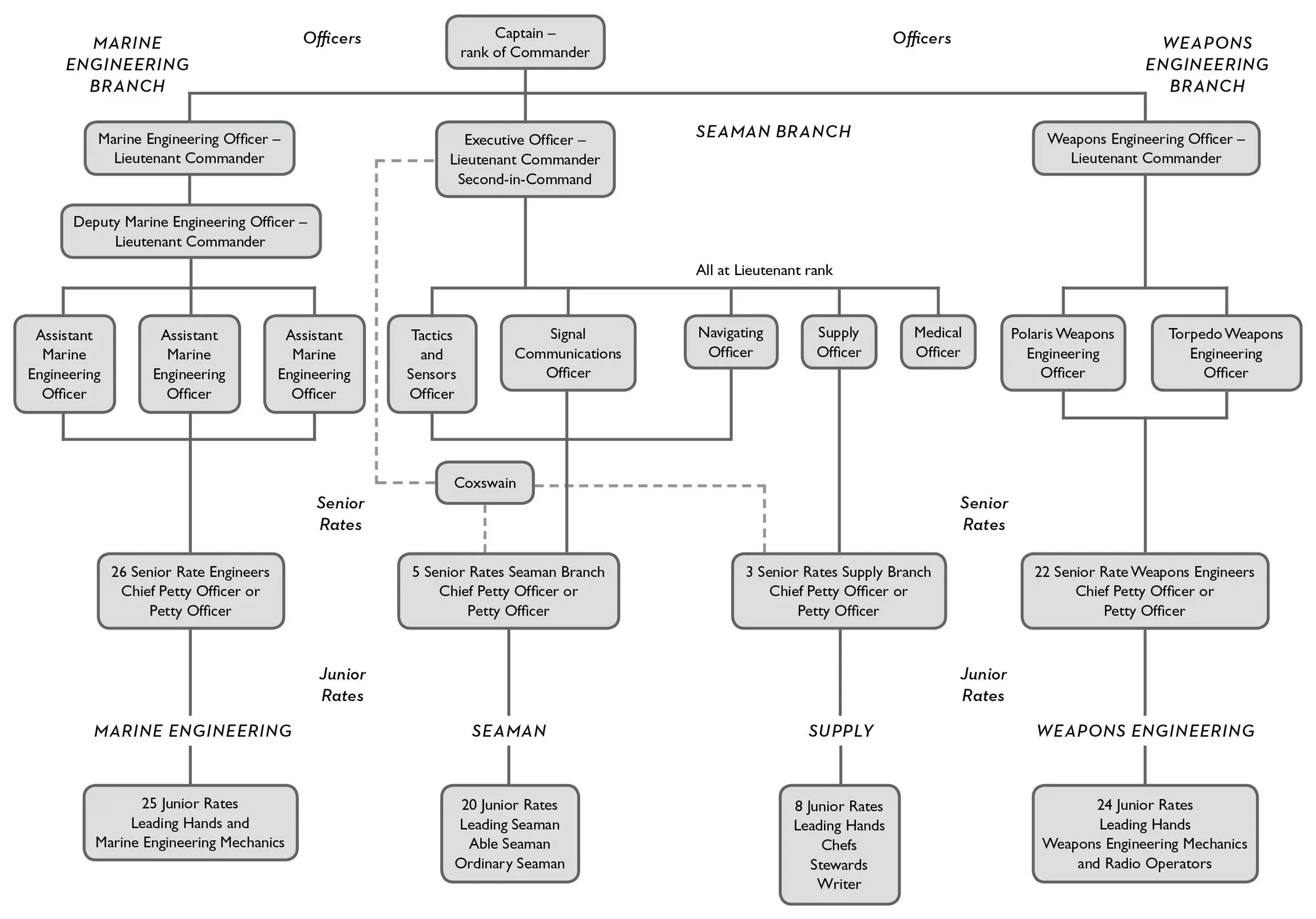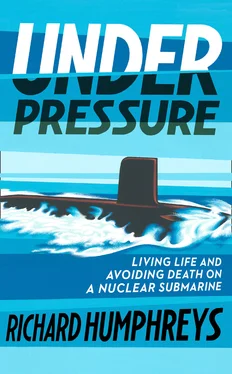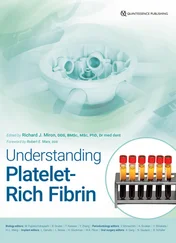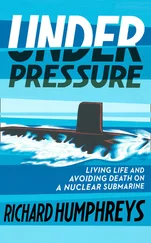Diagram of Polaris Submarine

Polaris Submarine Hierarchy

Terminology
alongside: status of submarine when berthed at jetty, in Resolution ’s case at Faslane, awaiting to go to sea for patrol or work-up. Also where ship maintenance, storing ship, and loading both missiles and torpedoes – at Coulport – take place.
AMS (auxiliary machinery space): three areas on the submarine – AMS 1, 2 and 3 – where various bits of machinery are located.
angles and dangles: deep-water procedure where submarine dives and heads back to surface at steep inclines to test if boat is safely stowed for sea. Any noise generated by falling pots, pans or bits of machinery could give boat’s position away on patrol. Great fun.
ARL (Admiralty Research Laboratory) table: located aft and on starboard side of control room. Mostly used when surfaced. Map lies on top of it and periscope navigational fixes taken from landmarks are applied to chart to calculate submarine’s position in conjunction with SINS.
attack team: warfare team under guidance of XO reporting to captain, who has overall command. Consists of sonar team, tactical systems team, warfare seaman officers, XO and captain.
auxiliary vent-and-blow system: back-up vent-and-blow system in case of failure of main systems. May be used for diving and surfacing of submarine.
bathythermograph: instrument to measure changes in water temperature at different depths. Also used to measure velocity of sound in water. Sensors located in top of fin and keel.
BRN mast: supplies submarine with instantaneous navigation information to lock down its latitude and longitude at PD.
bubble: ‘up bubble’ means bow of submarine is angled up; ‘down bubble’, bow angled down; ‘zero bubble’, boat kept steady on depth. Controlled by afterplanesman.
casing: outer non-watertight upper hull of submarine, designed for hydrodynamic performance. Pressure hull is the inner hull.
CEP (contact evaluation plot): time-bearing plot constantly in operation on patrol where every sonar contact is plotted so its course, range and speed can be calculated for firing solution or to avoid collision.
control room: centre of operations, where captain commands submarine and planesmen manoeuvre, surface, dive, and go to and from PD using ship control console. Houses attack and search periscopes, attack team fire-control and plotting systems. Systems console located here, which controls ballast and trim pumps, hover pump and periscopes. Slop, drain and sewage tank is blown here and hydraulic system monitored.
Coulport (Royal Navy Armament Depot Coulport): on Loch Long, Scotland. Military facility that stores and loads Britain’s nuclear weapons carried by submarines, first Polaris, then Trident.
1 Deck: nav centre, control room, wireless office, sound room, sonar console space, electronic warfare (EW) shack containing radar room, electrical equipment space with closed room containing navigator’s maps.
2 Deck: entertainment and living spaces: wardroom and officers’ bunks, senior rates’ mess and annex, upper bunk space, coxswain’s office, sick bay, galley, scullery, junior rates’ dining area and mess in upper level of torpedo compartment.
3 Deck: senior and junior rates’ bunks, junior rates’ toilets, laundry, AMS 1, missile control centre.
dolphins: gold submariners’ qualification badge to denote fully qualified submariner, gained after passing on-board oral examination. Panel consists of XO, chief engineer and coxswain. Worn on upper-left chest.
EBS (emergency breathing system) mask: used in emergencies when fire causes poisonous smoke to billow through submarine. Plugged into various couplets around submarine, known as built-in breathing system, which supplies fresh supply of air.
emergency surface procedure: to avoid catastrophic fire, flooding and sinking of boat, all watertight bulkhead doors are shut, full ahead is selected on engine telegraphs, emergency air supply is used to fill ballast tanks with air, causing submarine to surface as quickly as possible with planesmen controlling pitch.
Faslane (HMS Neptune): on Gare Loch, Scotland. One of Royal Navy’s three operating bases. Centre of naval operations in Scotland and home of the nuclear missile-carrying submarines, in my day Polaris, now Trident.
fire-control system: computerised system on submarines, designed by Ferranti and Royal Navy, using series of pre-set algorithms and other tactical information from on-board time-bearing plots and sonar room to calculate firing solutions for torpedoes to target and hit enemy vessels.
flying the boat: phrase suggesting submarine has similar moving characteristics to aircraft while dived, with pitch and depth controlled by foreplanes and afterplanes tilted either up or down to make submarine push upwards to surface or dive towards deep. Amount of angle on planes coupled with speed of boat determines angle of descent or rise, just as an aircraft’s lift by its wings is determined by speed and angle of attack.
gash: collective name for all the rubbish on a submarine, collected, crushed and fired out by gash gun into ocean.
goffa: non-alcoholic soft drink.
HMS Dolphin (Gosport): former shore-side centre for submarine training. Royal Navy Submarine School was relocated to HMS Raleigh (Torpoint) in 1998.
LOP (local operations plot): time-bearing plot using information from sound room or periscope to calculate target motion analysis on ship or submarine contacts.
PD (periscope depth): depth equal to length of periscope when dived.
Perisher: Submarine Command Course, so-called because candidates pass or perish. Run twice a year for c. 24 weeks, taking in simulation exercises shore-side and sea-going exercises on nuclear submarine. Success leads to second-in-command, then captaining nuclear submarine. Failure, a bottle of whisky and never again setting foot on submarine.
pipe: boatswain’s call used by quartermaster to pipe aboard captain on change of crews and pipe exiting captain off boat. Also used for flag officers – rear admiral and above – if visiting boat.
Polaris: Britain’s first submarine-based nuclear ballistic missile system, in service from 1968 to 1996, when the last Resolution -class submarine in service, HMS Repulse , was decommissioned.
reactor: nuclear reactor in reactor compartment powers submarine, generating heat that creates steam to provide power for turbines, which turns propeller, and for all electrical equipment and machinery to maintain life-support systems.
‘Resolution’ class: four nuclear ballistic missile submarines (SSBN) built for Royal Navy as part of Polaris programme, each armed with up to 16 UGM-27 Polaris A-3 nuclear missiles. The capital ships of the day, named after surface ships with a glorious past: Resolution , Revenge , Repulse and Renown .
scram: reactor shutdown to ensure core remains safe and doesn’t overheat, melting the boat.
scran: collective term for food, originally naval acronym for sultanas, currants, raisins and nuts once given to fight scurvy.
scrubbers: used to remove CO2 from submarine so crew don’t die of asphyxiation.
SETT (submarine escape training tank): vast concrete tower at HMS Dolphin , Gosport, where simulated escapes take place.
Читать дальше














